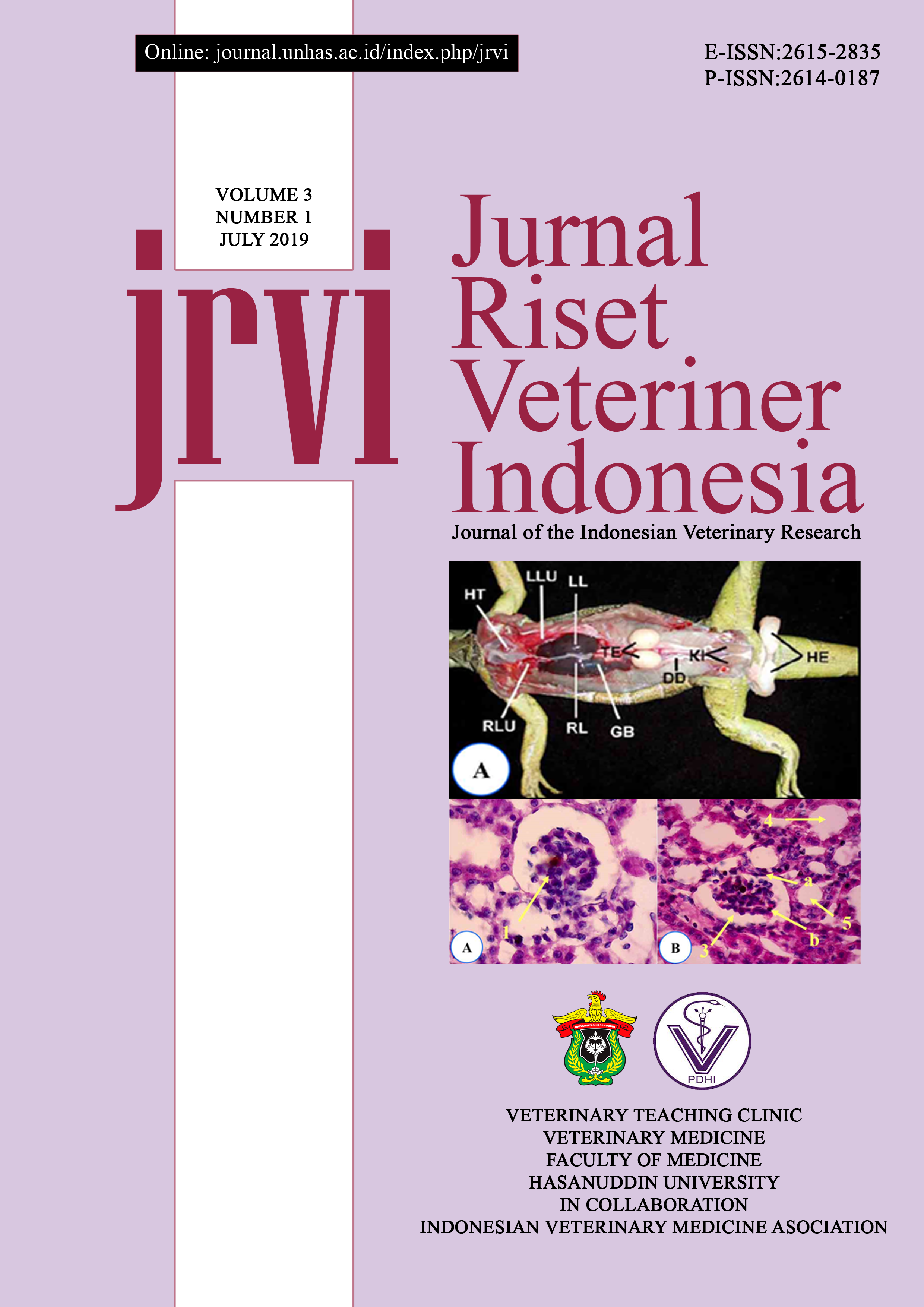Abstract
The purpose of this study was to test the resistance and to detect antibiotic resistence encoding gene in E. coli bacteria from chickens in Bandung and Purwakarta livestock. 18 E. coli isolates were tested for antibiotics resistance using the disk diffusion method. Isolates that were categorized as resistant and intermediate to antibiotics, then polymerase chain reaction was utilized to detect the resistent coding gene. The test results showed that all E. coli isolates from chickens in Bandung and Purwakarta were resistant to ampicillin (100%). E. coli isolates were still sensitive to chloramphenicol (11.1%) and gentamicin (22.2%). The gene encoding for ampC resistance from the test were in the amount of 77.7%. Sensitivity test results and detection of resistance coding gene showed that almost all isolates were resistant to ampicillin antibiotics and E. coli isolates were still sensitive to chlorampenicol and gentamicin.
References
Ajayi AO, Oluyege AO, Olowe OA, Famurewa O. 2011. Antibiotik resistance among commensal Escherichia coli isolated from faeces of cattle in Ado-Ekiti, Nigeria. J Anim Vet Adv. 10(2):174-175.
Amalia Z, Adisasmito W. 2017. Analysis of Policy making Factors on The Prohibition of Hormones and Antibiotcs Use for Feed as a public health Protection. JIHPA. 2(@): 14-19.
Barton MD. 2000. Antibiotic use in animal feed and its impact on human health. Nuutr Res Rev. 13(2):279-299.
Brinas L, Zarazaga M, Sa’enz Y, Larrea FR, Torres C. 2002. ᵝ-Lactamases in ampicillin-resistant Escherchia coli isolates from foods, humans, and healthy animals. Antimicrob Agents Chemother. 46(10):3156-3163.
[CLSI] Clinical and Laboratory Standards Institute. 2018. Perfomance Standards for Antimicrobial Susceptibility Testing 28th ed. CLSI Suplement M100. Wayne, PA : Clinical and Laboratory Standars Institute ; 2018.
Ibrahim DR, Dodd CER, Stekel DJ, Ramsden SJ, Hobman JL. 2016. Multidrug resistant, Extended Spectrum β-Lactamase (ESBL)-producing Escherichia coli from a dairy farm. FEMS Microbiol Ecol. 92(4):1-13.
Jacoby GA. 2009. AmpC ß-Lactamases. Clinical Microbiology Reviews, Jan. 2009, p. 161–182
Laxminarayan R, Duse A, Wattal C, Zaidi AKM, Wertheim HFL, Sumradit N, Vlieghe E, Hara GL, Gould IM, Goossens H, Greko C, So AD, Bigdeli M, Tomson G, Woodhouse W, Ombaka E, Peralta AQ, Qamar FN, Mir F, Kariuki S, Bhutta ZA, Coates A, Bergstrom R, Wright GD, Brown ED, Cars O. 2013. Antibiotic resistance- The need for global solutions. Lancet infect. Di. 13: 1057-1098
Martin, S.W., Week, A.H. and Willenberg, P., 1987. Veterinary Epidemiology Principles and Methods, 1st ed. Iowa State University Press, Ames: 22-175.
Noor SM, Poeloengan M. 2005. Pemakaian antibiotik pada ternak dan dampaknya pada kesehatan manusia. Prosiding lokakarya nasional keamanan pangan produk peternakan. Bogor (ID): Puslitbang Peternakan. 18-22.
[OIE] Office Internationale des Epizooties. 2013. Harmonisation of national antimicrobial resistance surveillance and monitoring programmes chapter 6.7. [Internet]. [diunduh 2013 September 3]. Tersedia pada: www.oie.int/fileadmin/Home/eng/Health_standards/tahc/2010/en_chaptire_1.6.7.htm.
[SNI]. Standar Nasional Indonesia. 2008. Metode Pengujian Cemaran Mikroba dalam daging, telur, dan Susu serta Hasil Olahannya. SNI 2897. ICS 67.050. Jakarta, Indonesia (ID): SNI.
Soemarno. 2000. Isolasi dan identifikasi bacteri klinik. Yogyakarta. Akademi Analis Kesehatan Yogyakarta Departemen Kesehatan RI.

